-
开放科学(资源服务)标识码(OSID):

-
随着大量杀虫剂、化肥以及畜禽养殖所产生粪肥的施用,农田土壤中的无机污染物污染已经成为全球性环境问题[1-2]。相较于其他易分解的营养盐和有机物,无机污染物属于累积性污染物,具有环境持久性、毒性和生物蓄积等特点,能够在土壤、水体和大气中长期存在,并逐渐积累至危险阈值以上,对土壤生态系统产生持久的毒性影响[3-7]。农田无机污染物污染现象广泛存在,中国受无机污染物污染的耕地面积达到了约1×107 hm2,经济损失超过200亿元[8]。农药和化肥的长期施用,使得农田土壤成为无机污染物的长期汇聚地[9]。高浓度的无机污染物是土壤质量退化的重要原因,不仅会导致土壤肥力下降、粮食产量降低,还会对食品安全和人类健康构成威胁[10-14]。因此,科学认识并评估流域农田无机污染物引发的污染,对于流域土壤质量的提升和生态环境的治理具有重要意义。
为了采取有效的污染防治措施,确定土壤中无机污染物的来源至关重要。理论上,农田土壤中无机污染物的来源可以分为自然来源和人为来源两部分。自然来源包括地质成因和大气沉降等过程;人为来源归因于农药和化肥的施用等[9, 15]。无机污染物并非孤立存在,而是与周围的环境因子相互作用,污染源释放的无机污染物通过环境因子的影响沉积到土壤中。因此,评估无机污染物与环境因子之间的关系,有助于综合分析无机污染物提升的原因[16]。国内外针对农田污染已有大量研究,研究人员利用Pearson相关系数分析、聚类分析等方法,发现不同无机污染物质量分数之间存在相关性,将主成分分析法与PMF受体模型、自组织神经网络模型相结合,进一步明确了无机污染物的来源[17-19]。部分学者还结合污染负荷指数、内梅罗综合污染指数、地累积指数和潜在生态风险指数等方法,评估了污染物的生态风险,取得了丰富的研究成果[20-24]。
三峡库区水土流失风险较高且人地矛盾突出,化肥和农药的长期施用加剧了库区土壤无机污染物的污染风险。王家沟流域作为三峡库区的典型流域,评估其无机污染物的污染特征并解析其来源,对于污染防控和库区生态治理具有重要意义。鉴于此,本研究以王家沟流域为研究对象,基于相关性分析和主成分分析法,结合地累积指数、污染负荷指数和潜在生态风险指数综合评估无机污染物引起的生态风险。本研究的主要目标为评估流域农田土壤无机污染物的污染特征,描述环境因子与无机污染物的相关性,解析无机污染物的来源,以期能够为农田土壤无机污染物的风险评价和污染防控提供科学依据。
HTML
-
王家沟流域(107°30′E,29°54′N)位于三峡库区涪陵区珍溪镇附近。流域内的海拔为186~317 m,地形以丘陵为主,平均坡度为15.10°。流域属于典型的亚热带季风性湿润气候,年平均降水量约为1 011 mm,年平均气温约为22.10 ℃,降水主要集中在6-10月。研究区域土壤母岩为侏罗系遂宁组岩层发育而成的紫色土,土壤结构较差,保水能力较弱,pH值介于中性至微碱性之间,有机质质量分数较低,抗冲刷和抗蚀能力较差。
-
样品采集时,避开新搬运的堆积土、垃圾堆以及明显的污染区域[3]。采用五点混合采样法进行采集,采样深度为0~20 cm,混合形成具有空间代表性的复合样品,每个样品采集2 kg,并装入自封袋中,共采集了85个土壤样品,采样点分布如图 1所示。样品经自然风干,按照标准方法研磨,过100目筛。采用重铬酸盐容量法测定有机质质量分数,电位法测定土壤pH值,激光粒度分析仪测定土壤粒径。样品用3 mL浓盐酸和9 mL浓硝酸进行消解,As、Cd、Cr、Cu、Ni和Zn的质量分数通过电感耦合等离子体—光学发射光谱法(ICP-OES)测定。测试过程中,采用国家一级标准物质(GBW07559)和空白样品进行质量控制,实验误差保持在可接受范围内(±5%)。
-
地累积指数由德国科学家Muller[25]提出,通过定量评价单项无机污染物的总量与所在地区背景值之间的相互关系,来衡量无机污染物的累积程度。地累积指数充分考虑了人类活动和自然成岩等因素对背景值的影响,因此广泛用于泥沙和土壤中无机污染物的研究[25-26],其计算公式为:
式中:Igeo为地累积指数;Ci为无机污染物元素实际测量值(mg/kg);Bi为所在地区背景值(mg/kg),选择重庆市土壤元素背景值[27],污染分级标准如表 1所示。
-
污染负荷指数法是一种评价多种无机污染物对污染贡献程度的方法,能够避免加和关系对评价结果的影响[25, 28-29],其计算公式为:
式中:PLI为污染负荷指数;CF为污染因子指数,可由无机污染物与其背景值的比值计算得出;n为无机污染物种类数(个);PLI评价分级标准如表 1所示。
-
潜在生态风险指数由瑞典科学家Hakanson[30]提出,该方法基于无机污染物的理化性质与环境因子的相互作用,综合考虑了无机污染物的毒性效应及沉积特征,用于评价无机污染物的污染程度及其潜在生态风险[25, 30],其计算公式为:
式中:RI为综合生态风险指数;Eri为无机污染物i的潜在生态风险指数;Tri为毒性响应系数;Wi为元素实测值(mg/kg);Bi为背景值(mg/kg);Zn、Cr、Cu、Ni、As、Cd的毒性响应系数分别为1、2、5、5、10、30[1, 30]。
1.1. 研究区域概况
1.2. 样品采集与实验室分析
1.3. 评价方法
1.3.1. 地累积指数
1.3.2. 污染负荷指数
1.3.3. 潜在生态风险指数
-
无机污染物的质量分数变化能够反映是否存在外部污染,并有助于评估人类活动的影响。As、Cd、Cr、Cu、Ni、Zn质量分数的平均值分别为3.61、0.35、24.21、7.16、107.36、42.81 mg/kg(表 2)。与土壤元素背景值相比,除Cd和Ni外,As、Cu、Cr、Zn质量分数的平均值均低于背景值。Cd和Ni的质量分数分别为背景值的3.18倍和3.36倍,表明受人类活动影响,需要进一步分析其来源。
无机污染物的空间分布具有相似性与差异性。Cd和Ni的空间分布高度相似,主要表现为从西北方向到东南方向递减的趋势,西北方向为高值区,东南方向为低值区;Cr、Cu和Zn显示出相似的空间分布特征,西北和东南地区的质量分数均偏高;As的高值区主要分布在西北和中部地区(图 2)。
-
本研究采用了3种评价方法来评估农田土壤中无机污染物的污染状况。地累积指数(Igeo)均值从大到小依次为Zn(11.14)、Ni(11.14)、Cr(10.33)、Cu(6.93)、As(3.49)、Cd(-5.36)(图 3a)。Zn、Ni、Cr和Cu处于极度污染水平,地累积指数超过了6,且占比均为100%。As绝大部分处于中度至重度污染和重度污染水平,其占比分别为18.82%和63.53%。Cd的地累积指数小于0,表明Cd处于无污染水平。
污染负荷指数(PLI)均值从大到小依次为Ni(3.36)、Cd(3.15)、As(0.72)、Zn(0.54)、Cr(0.30)、Cu(0.28)(图 3b)。Ni处于重度污染和中度污染的占比分别为70.59%和29.41%。Cd处于重度污染、中度污染和轻度污染的占比分别为57.65%、30.59%和11.76%。As、Zn、Cr和Cu则处于无污染水平。
潜在生态风险指数(Eri)均值从大到小依次为Cd(94.40)、Ni(16.78)、As(7.22)、Cu(1.38)、Cr(0.61)、Zn(0.54)(图 3c)。Cd处于中等危害和强危害的占比分别为28.24%和71.76%,Ni、As、Cu、Cr和Zn均处于轻微危害水平。
综合生态风险指数(RI)值从大到小依次为Cd(8 023.64)、Ni(1 425.92)、As(613.39)、Cu(117.04)、Cr(51.45)、Zn(45.49)。这一结果与单项生态风险指数的结果存在差异,Cd、Ni和As的综合生态风险指数均超过了600,表明它们具有很强危害,这可能是由于点位累积效应的影响,导致了不同的结果。
-
两种元素的关联越强,表明它们可能是同源或伴生的可能性越大,因此相关性分析可用于土壤无机污染物的溯源分析[1]。通过环境因子与无机污染物之间的相关性,可揭示引起无机污染物质量分数变化的原因。根据分类标准,将土壤粒径分为黏粒、粉粒和沙粒3个等级。根据相关性分析结果可知,土壤pH值与Cd、Ni和Zn的质量分数呈正相关,土壤黏粒与Cd和Ni的质量分数呈负相关,土壤沙粒与Cd的质量分数呈正相关,而与Cr的质量分数呈负相关,土壤粉粒与Cr的质量分数则呈正相关(图 4)。
对As、Cd、Cr、Cu、Ni和Zn进行了主成分分析,结果表明,KMO值为0.594,Bartlett球形检验显著性水平为0.00(p<0.001),这表明利用主成分分析解析无机污染物来源是可行的。主成分分析结果如表 3所示。经Kaiser选择特征值大于1的因子,提取了2个主成分,共同解释了67.32%的总方差,剩余的32.68%不能由这些因素解释。这2个主成分代表了影响土壤中无机污染物分布的两大因素,由此可以推测研究区土壤无机污染物主要来源为2个。第一主成分(PC1)贡献率为48.93%,由Cd、Cr、Cu、Ni和Zn 5种元素组成,载荷系数为强负荷,分别为0.614、0.809、0.702、0.721和0.909,第二成分(PC2)贡献率为67.32%,As具有较大的载荷,载荷为0.474。
2.1. 无机污染物描述性统计和空间分布特征
2.2. 土壤无机污染物污染评价
2.3. 土壤无机污染物的相关性分析与主成分分析
-
Cd和Ni的质量分数在85个点位上超出了背景值,超标率达到了100%。Cd和Ni的质量分数为背景值的3.18倍和3.36倍,这表明人类活动可能对Cd和Ni的质量分数产生了影响,Cd和Ni存在明显的富集现象。土壤中无机污染物的空间分布至关重要,尤其在环境管理和修复领域[11]。总体来看,无机污染物的空间分布存在差异性,As、Cd和Ni的高值区出现在西北部,Cr、Cu和Zn在西北和东南均出现了高值区域,这可能是因为它们具有相同的来源。变异系数被用于揭示环境中无机污染物的来源,As、Cd、Cu、Ni和Zn的变异系数属于中等空间变化范围,这表明无机污染物具有相当大的可变性,并且其空间分布不均匀。土壤中的无机污染物可能来源于地质因素和人为活动的混合影响[31-32]。
-
由相关性分析的结果可知,Cd和Ni受pH值的影响。pH值是土壤最重要的理化性质之一,其变化会导致无机污染物的吸附点位、吸附表面稳定性和存在形态等发生变化,从而影响无机污染物的形态和活性[33]。土壤的pH值还会影响土壤表面电荷,进而影响无机污染物与特定吸附位点的亲和力,改变其溶解度[34]。从微观角度看,pH值的变化可以通过系统性地改变有机官能团,从而显著影响土壤中离子的吸附强度[35-36]。农业管理模式、地表植被以及根系渗出物造成的土壤微生物环境变化,也会影响农田土壤中无机污染物的活性和迁移特性,进而影响无机污染物的存在形式和性质[37-39]。土壤粒径是另一个重要因素,可显著影响土壤中无机污染物的质量分数,因为它决定了土壤颗粒的迁移率[40-41]。黏粒土壤能够提高土壤pH值,降低土壤中可化学提取部分和重金属的生物利用度,并降低无机污染物的质量分数[42]。土壤中的沙粒与Cr的质量分数呈现负相关关系,与Cd的质量分数呈现正相关关系。一般来说,随着土壤粒径的减小,由于比表面积和有效成分的增加,细小土壤颗粒中会积累更多的无机污染物[43]。
As、Cd、Cr、Cu、Ni和Zn的来源途径是多样的。作为地壳的组成部分,As、Cd、Cr、Cu、Ni和Zn天然存在于环境中,受地层岩性和成土母质等多种因素的影响,通过水土流失和大气沉降等过程进入土壤,从而导致元素的富集[11, 44-45]。由于周围环境的变化,Cd和Ni可能会通过植被或地表径流迁移[11, 46-47]。Cd和Ni的污染最为严重,除了成土母质的影响外,它们的来源更可能与农业活动有关。王家沟流域是典型的农业流域,杀虫剂和农药中含有Cd和Ni,长期使用势必导致Cd和Ni的富集。Cd在磷肥中通常以杂质的形式存在,肥料已被确定为土壤中Cd的主要来源之一[48]。研究发现,在土壤中施用肥料和粪肥4年后,Cd的平均质量分数相比初始值增加了17.27%[39, 49]。此外,由生活和畜禽饲养产生的污泥、污水中也可能携带Ni,这些污泥、污水可能在之后农业生产过程中被用作灌溉水及肥料施用在土壤中,导致Ni的累积[50]。
-
农田土壤无机污染物的防控和修复主要包含3个方面:去除无机污染物总量、降低无机污染物活性以及控制无机污染物在生物体之间的转移[36]。对受无机污染物污染的农田进行治理修复,不仅能够提升耕地和农产品质量,增加粮食产量,还能有助于维护区域民众的健康[51]。然而,农药、化肥的施用和频繁的人类活动加剧了农田无机污染物的污染。因此,应考虑采取可持续的农业实践措施,减少无机污染物的来源,例如,提高肥料利用率、选择非金属杀虫剂、使用生物炭和土壤钝化等[52]。
目前,针对农田Cd和Ni的污染问题,三峡库区广泛采用了土壤钝化技术进行治理。土壤钝化能够减少无机污染物在土壤中的累积,降低无机污染物的质量分数,从而实现安全生产和污染治理的目标[50]。土壤钝化技术以土壤pH值为切入点,通过向受Cd污染的农田土壤中施入生物炭等碱性材料,能够有效降低土壤孔隙水中的Cd和有效态Cd的质量分数[53]。此外,将沸石和磷酸钙镁肥料等钝化剂施入土壤中,能够降低Cd的生物利用度、改善土壤的化学性质。组合使用无机钝化剂可以实现高效的Cd钝化,进而降低Cd的质量分数[54]。生物修复技术已被广泛地应用于被无机污染物污染的土壤,栽植狗牙根等植物也能减轻Cd的污染。这些植物对Cd和Ni等无机污染物具有很强的转运能力,在无机污染物修复方面具有潜力。螯合剂(如乙二胺四乙酸等)淋洗能够显著升高土壤内Cd和Ni的结合强度系数,降低迁移指数,从而减少土壤中重金属的潜在生态风险[55]。
-
1) 流域农田土壤中Cd和Ni质量分数的平均值高于背景值。Cd和Ni具有明显的空间分布特征,西北部为高值区,东南部为低值区。
2) 地累积指数的评价结果显示,Zn、Ni、Cr和Cu这4种元素处于极度污染状态,As也处于较高的污染水平,而Cd则处于无污染状态。污染负荷指数结果显示,Ni和Cd处于重度污染水平。综合生态风险指数结果显示,Cd、Ni和As在流域内具有很大的生态风险。结合土壤背景值分析,确定Cd和Ni具有很大的生态风险。
3) 相关性分析和主成分分析的结果显示,土壤pH值与Cd和Ni的质量分数呈现正相关关系,土壤黏粒与Cd和Ni的质量分数呈现负相关关系,这与土壤表面电荷等因素有关。地质成因、成土母质的岩石风化、农药化肥的施用以及人类活动是无机污染物的主要来源。通过控制无机污染物来源的输入,结合土壤钝化和生物修复等技术(如使用生物炭和栽植狗牙根等),可有效进行污染防控。

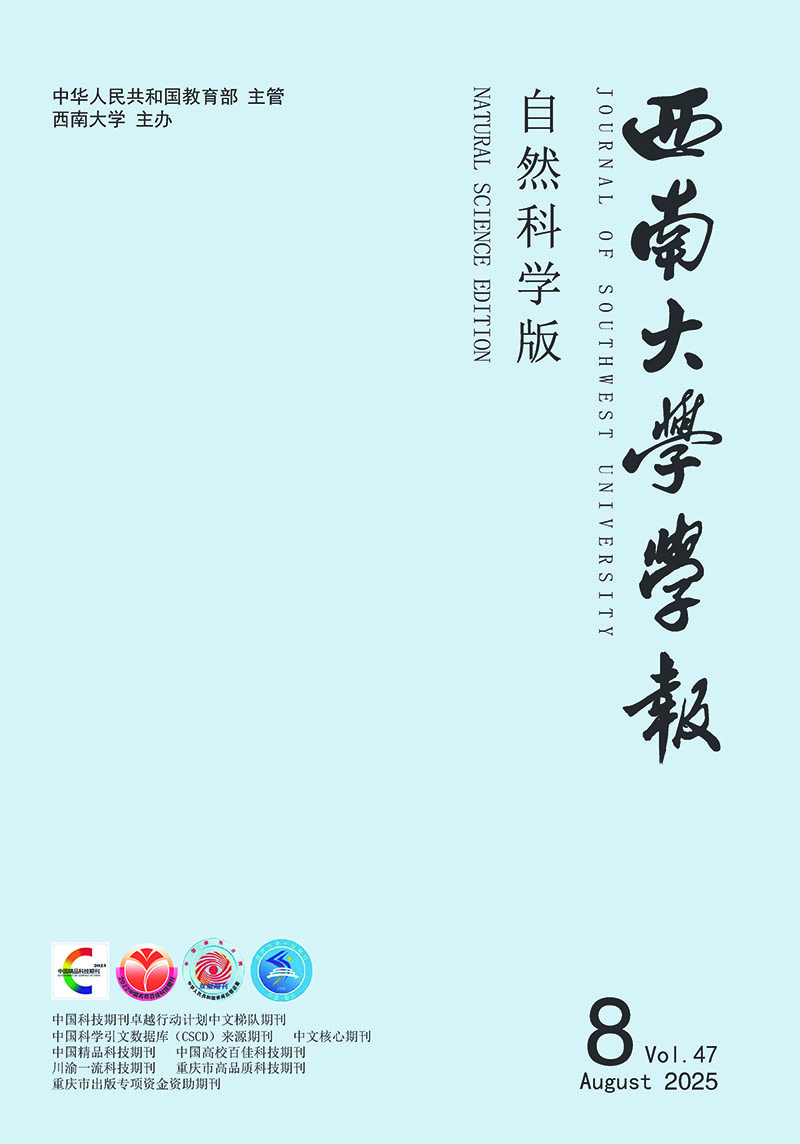


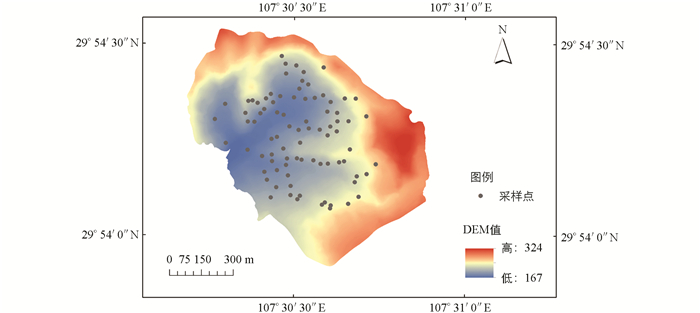


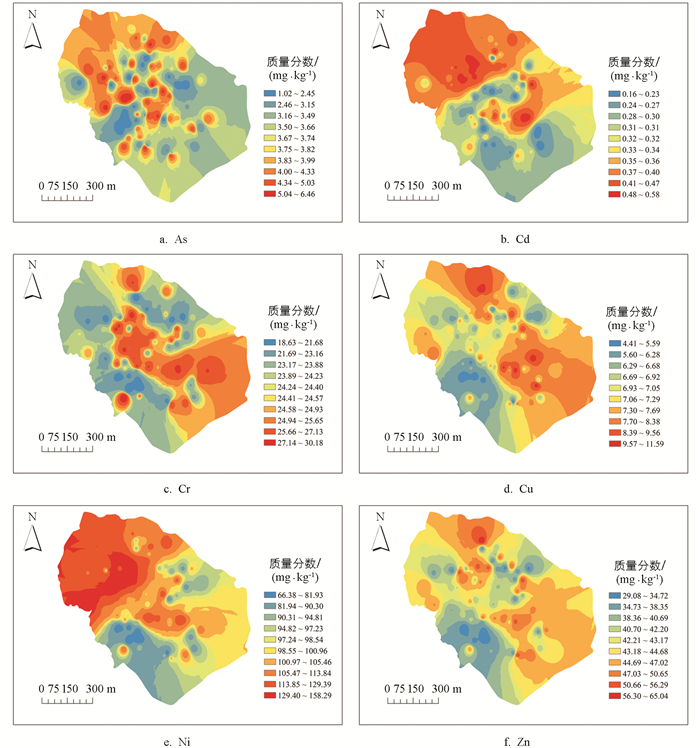
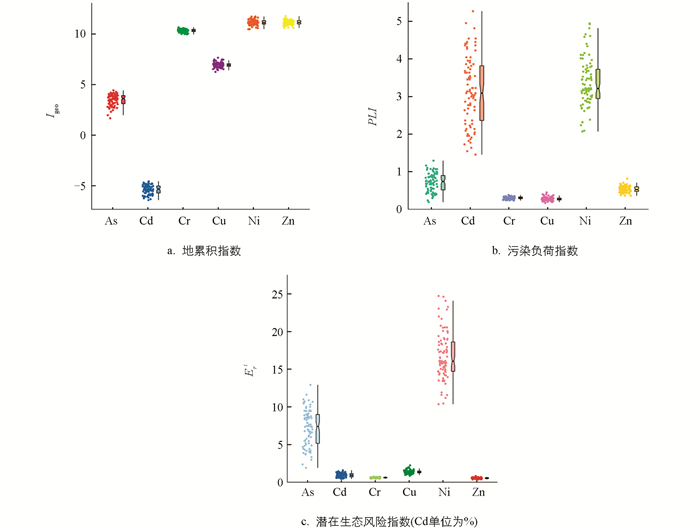
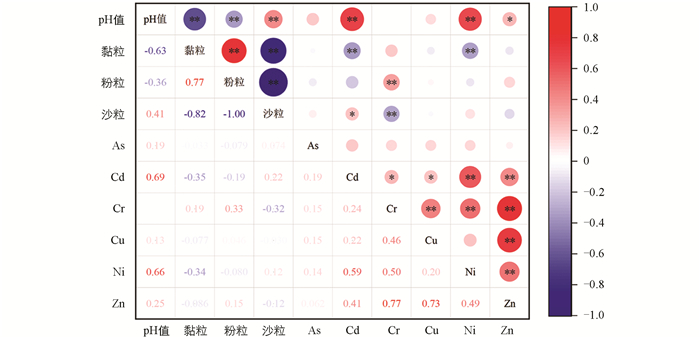
 DownLoad:
DownLoad: